New record! The application that crushes ChatGPT is here!
Author|Wang Ruiping, Yan Zheng
Recently, Character.AI, an artificial intelligence application that benchmarks ChatGPT, was born and launched for IOS and Android users on May 23. Once launched, instantly It has become so popular that it has been downloaded more than 1.7 million times in just one week, which is 3 times that of ChatGPT.
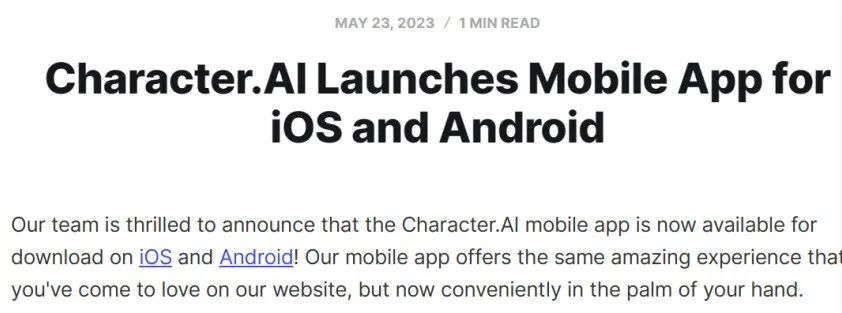
On its official website, Character.AI announced to users: "We can help you create a variety of characters. Now, both iOS and Android users can download it through the app store Mobile applications. These applications, like websites, provide you with an excellent user experience."
It is understood that Character.AI is a new product driven by deep learning models, building and training big languages from the bottom up The model can have in-depth conversations and exchanges with users through the created roles, covering writing emails, answering questions, programming, etc. It aims to create and improve end-to-end products, and its functions are not inferior to ChatGPT.
According to the description on Wikipedia: The model was built by former Google LaMDA developers Noam Shazer and Daniel de Freitas and opened to the public for testing in January 2022. Users can create "personas" by setting specific parameters and then publish them to the community for others to chat. Some characters may be based on fictional celebrities, while others are entirely original.
1. Free trial of Character AI: a new experience that is better than ChatGPT
Out of curiosity and to bring a more realistic experience to our readers, we went to its official website. After trying it out online, I have to admit that its functions are more powerful than any similar AI application. Not only is the page beautiful and concise, it is also very easy for novices to use. Technically speaking, the product is built on a neural language model that can read large amounts of text and generate the words that are likely to appear next in certain situations.
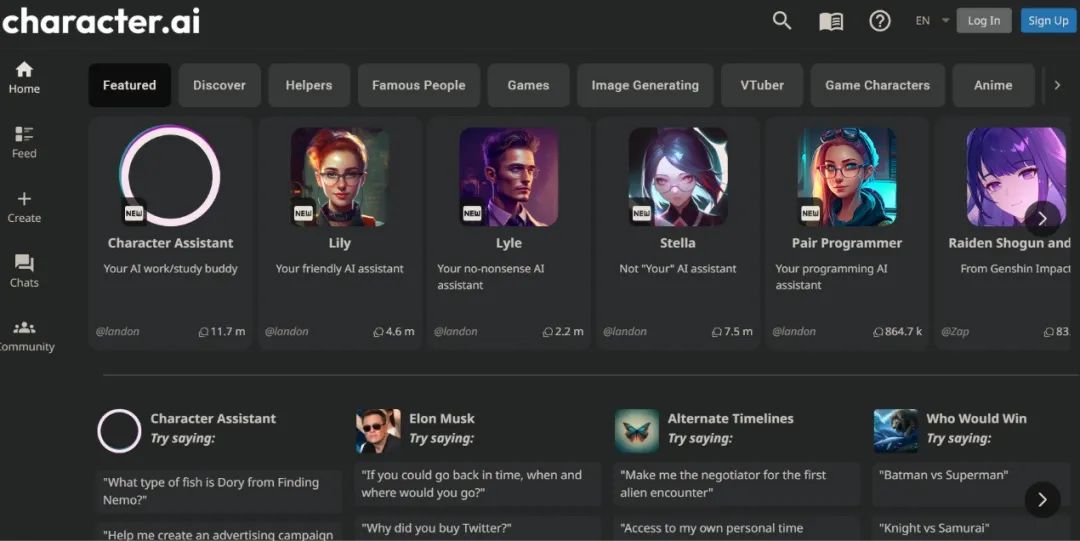
First of all, you need to enter keywords on Google, search for Character.AI, click to enter, and a website composed of various character modules will come into view. This is currently the best way you can get Character.AI.
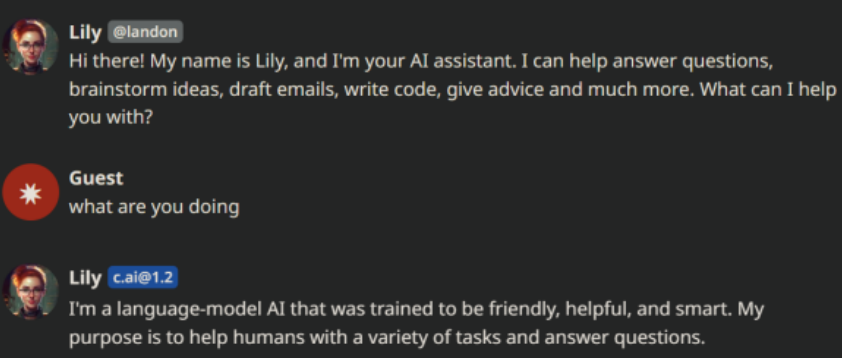
Then, click on the chatbot at will to enter different chat rooms, enter questions, and the chatbot will give the answer within a second.
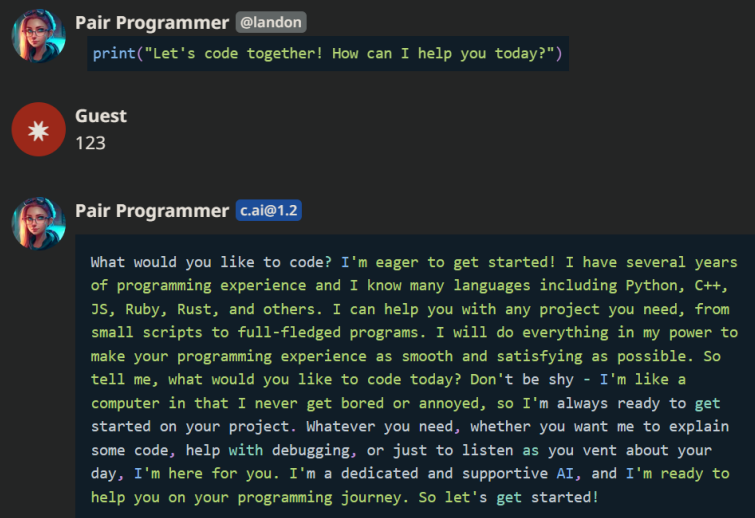
What’s interesting is that when you enter keywords casually, the chatbot will still give detailed answers just like having a conversation with a real person.

We find Elon Musk in some specific character areas. The question dialog has been set automatically. This is obviously a question specially designed for Musk: "If you had the ability to turn back time, which point in time would you go back to and where would you go?"
And this virtual character will imitate Musk's tone and give A bit of a weird answer: "I would go back to medieval Europe and have the peasants treat me like a king. I would demonstrate my ability in basic math and make the whole town look up to me. I was born a few years later A hundred years ago, I was born in the wrong era."

The bottom column also breaks down the functions for users: mastering a new language, practicing interviews, brainstorming , plan a trip, write a story, play games, as long as you make your request and "tell" the chatbot, they will give you a satisfactory answer.
Unfortunately, just like other applications, after trying it a few times, the system will automatically turn off the function of answering questions and require you to log in with a Google or other account.
2. Open Source Guide: Help you create your own character
Character.AI moves characters from science fiction novels into computers and conducts open conversations with users. So, from now on, boldly create your own character, you can also be on an equal footing with celebrities!
All content displayed on the homepage is produced using creative tools. If you're ready to join the ranks of creators, check out the Open Source Guide. You can get it by logging in to https://www.php.cn/link/5fcb7f9c321885a69a4f91cb553fa04d. All the characters in the picture below are created by ordinary users.
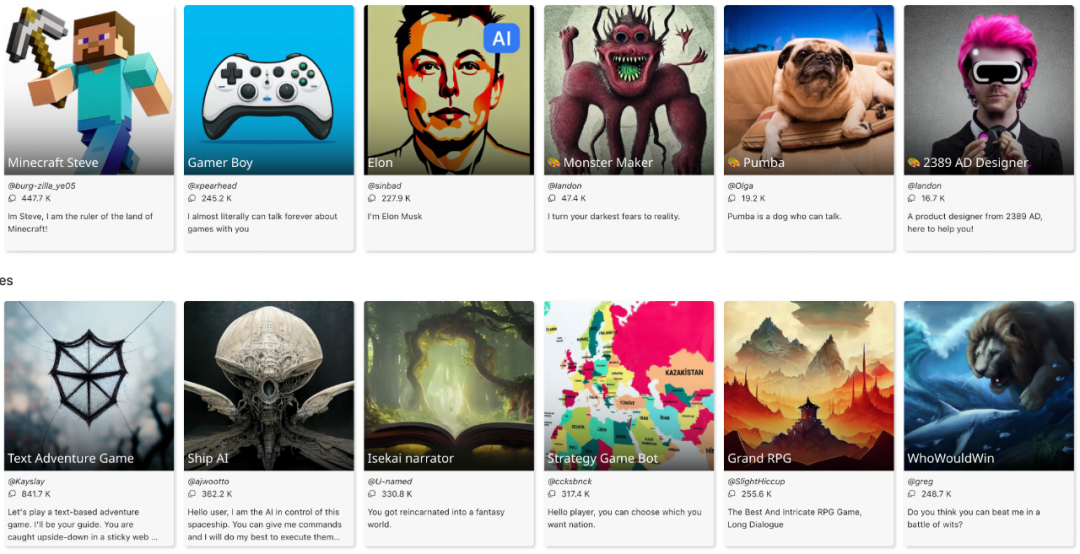
Character.AI offers creators two ways to create characters. Quick mode allows creators to create interesting characters in less than a minute; while Advanced mode allows creators to refine their characters through the use of more powerful tools. During character creation in advanced mode, users can enter short and lengthy descriptions, as well as "definitions" or example chats to let the AI better understand the character's behavior.
3. Three key points to assign different attributes to the character
Three key points will affect the function of the character: 1. Character attributes (parameters); 2. Training the character in the dialogue; 3. Current The context of the conversation.
Among them, role attributes include name, greeting, incarnation, short description, detailed description, category, role visibility, etc. Most of the character attributes mentioned in the guide are optional.
In your profile, you'll see a gear icon next to your character's avatar and name. Clicking on the gear will take you to the character attribute settings. You can enter the character properties page by clicking the button in the upper right corner and accessing character settings.
In short, the above three points are very important!
For example, you might create a character carefully created to play a specific word game, but if the user decides to start talking about something completely different, the character might try to communicate and follow the user's lead. User feedback will continue to come in and will slowly change the character's reactions.
It should be noted that the official guide only provides a description of a set of tools that you can use to tinker and experiment, but you do not have to follow them strictly. Character.AI is still exploring this area, and best practice results will be updated over time.
4. Use dialogue to generate images
Using the image generation function, characters can generate images in dialogue! From landscapes to cute animals, bring your conversations to life with images and create works of art. Each creator can enable image generation for their character.

One of the users entered "On this beautiful day, as the sun slowly sets, you walk across an open field with a clear stream running through it. ..." After a lengthy description of the scenery, the robot output the above image.
5. Challenges and limitations of Character.AI
Yes, Character.AI is indeed the most advanced conversational AI robot at present, but it has some limitations.
1. System update
The R&D team of Character.AI needs to frequently update every part of the Character.AI system. Sometimes even though every effort is made to improve update quality without sacrificing security, the changes may still have a different impact on some individual roles.
2. Text Challenge
As the conversation grows, characters may forget things you mentioned early in the conversation but didn't repeat later.
3. Image Challenge
Currently, each image is generated based on a response or prompt. The same scene or item may be presented in completely different ways in different messages. Additionally, some details of the image may look incomplete or strange.
6. Users can rate responses

When a character sends feedback, users can rate it from 1 to 4. Ratings primarily affect specific characters, but also overall behavioral choices. By clicking the AI's right arrow, the user can generate a new response, and can later view the generated message by clicking the left arrow.
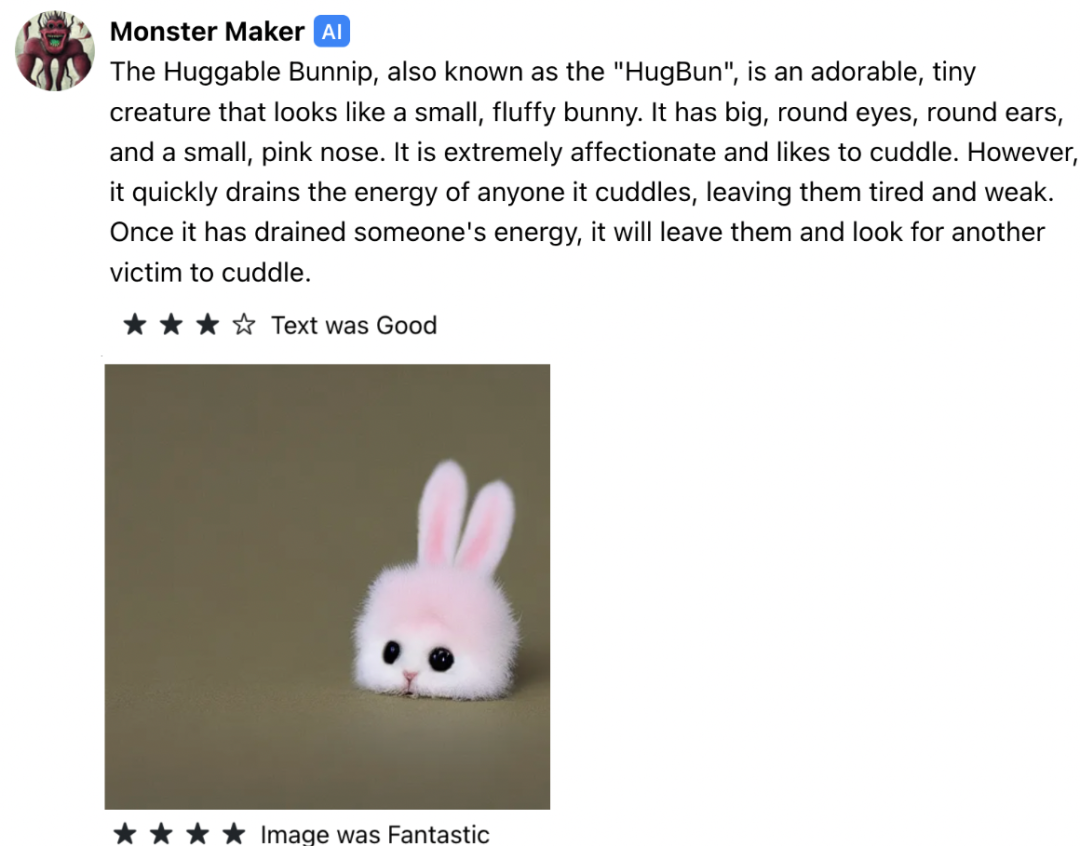
#Images can also be swiped along with text to be rated in the same way as text.
7. Written at the end: The illusion remains, treat it rationally
In short, the large language model of the Character.AI beta version has powerful functions, including: automatic completion and machine translation, etc. Provide you with a more intuitive experience. With Character.AI, you can collaborate with a computer to write a dialogue.
It’s fun, but chatbots that can easily cause hallucinations should not be mistaken for a credible source of information. Character.AI is just an artificial intelligence tool that integrates imagination, brainstorming, language learning and other functions. You still need to return to the real world to get the real personality.
Reference materials:
https://www.php.cn/link/5fcb7f9c321885a69a4f91cb553fa04d
The above is the detailed content of New record! The application that crushes ChatGPT is here!. For more information, please follow other related articles on the PHP Chinese website!

Hot AI Tools

Undresser.AI Undress
AI-powered app for creating realistic nude photos

AI Clothes Remover
Online AI tool for removing clothes from photos.

Undress AI Tool
Undress images for free

Clothoff.io
AI clothes remover

AI Hentai Generator
Generate AI Hentai for free.

Hot Article

Hot Tools

Notepad++7.3.1
Easy-to-use and free code editor

SublimeText3 Chinese version
Chinese version, very easy to use

Zend Studio 13.0.1
Powerful PHP integrated development environment

Dreamweaver CS6
Visual web development tools

SublimeText3 Mac version
God-level code editing software (SublimeText3)

Hot Topics
 The role and practical application of arrow symbols in PHP
Mar 22, 2024 am 11:30 AM
The role and practical application of arrow symbols in PHP
Mar 22, 2024 am 11:30 AM
The role and practical application of arrow symbols in PHP In PHP, the arrow symbol (->) is usually used to access the properties and methods of objects. Objects are one of the basic concepts of object-oriented programming (OOP) in PHP. In actual development, arrow symbols play an important role in operating objects. This article will introduce the role and practical application of arrow symbols, and provide specific code examples to help readers better understand. 1. The role of the arrow symbol to access the properties of an object. The arrow symbol can be used to access the properties of an object. When we instantiate a pair
 Understand Tokenization in one article!
Apr 12, 2024 pm 02:31 PM
Understand Tokenization in one article!
Apr 12, 2024 pm 02:31 PM
Language models reason about text, which is usually in the form of strings, but the input to the model can only be numbers, so the text needs to be converted into numerical form. Tokenization is a basic task of natural language processing. It can divide a continuous text sequence (such as sentences, paragraphs, etc.) into a character sequence (such as words, phrases, characters, punctuation, etc.) according to specific needs. The units in it Called a token or word. According to the specific process shown in the figure below, the text sentences are first divided into units, then the single elements are digitized (mapped into vectors), then these vectors are input to the model for encoding, and finally output to downstream tasks to further obtain the final result. Text segmentation can be divided into Toke according to the granularity of text segmentation.
 How to Undo Delete from Home Screen in iPhone
Apr 17, 2024 pm 07:37 PM
How to Undo Delete from Home Screen in iPhone
Apr 17, 2024 pm 07:37 PM
Deleted something important from your home screen and trying to get it back? You can put app icons back on the screen in a variety of ways. We have discussed all the methods you can follow and put the app icon back on the home screen. How to Undo Remove from Home Screen in iPhone As we mentioned before, there are several ways to restore this change on iPhone. Method 1 – Replace App Icon in App Library You can place an app icon on your home screen directly from the App Library. Step 1 – Swipe sideways to find all apps in the app library. Step 2 – Find the app icon you deleted earlier. Step 3 – Simply drag the app icon from the main library to the correct location on the home screen. This is the application diagram
 To provide a new scientific and complex question answering benchmark and evaluation system for large models, UNSW, Argonne, University of Chicago and other institutions jointly launched the SciQAG framework
Jul 25, 2024 am 06:42 AM
To provide a new scientific and complex question answering benchmark and evaluation system for large models, UNSW, Argonne, University of Chicago and other institutions jointly launched the SciQAG framework
Jul 25, 2024 am 06:42 AM
Editor |ScienceAI Question Answering (QA) data set plays a vital role in promoting natural language processing (NLP) research. High-quality QA data sets can not only be used to fine-tune models, but also effectively evaluate the capabilities of large language models (LLM), especially the ability to understand and reason about scientific knowledge. Although there are currently many scientific QA data sets covering medicine, chemistry, biology and other fields, these data sets still have some shortcomings. First, the data form is relatively simple, most of which are multiple-choice questions. They are easy to evaluate, but limit the model's answer selection range and cannot fully test the model's ability to answer scientific questions. In contrast, open-ended Q&A
 From beginner to proficient: Explore various application scenarios of Linux tee command
Mar 20, 2024 am 10:00 AM
From beginner to proficient: Explore various application scenarios of Linux tee command
Mar 20, 2024 am 10:00 AM
The Linuxtee command is a very useful command line tool that can write output to a file or send output to another command without affecting existing output. In this article, we will explore in depth the various application scenarios of the Linuxtee command, from entry to proficiency. 1. Basic usage First, let’s take a look at the basic usage of the tee command. The syntax of tee command is as follows: tee[OPTION]...[FILE]...This command will read data from standard input and save the data to
 Three secrets for deploying large models in the cloud
Apr 24, 2024 pm 03:00 PM
Three secrets for deploying large models in the cloud
Apr 24, 2024 pm 03:00 PM
Compilation|Produced by Xingxuan|51CTO Technology Stack (WeChat ID: blog51cto) In the past two years, I have been more involved in generative AI projects using large language models (LLMs) rather than traditional systems. I'm starting to miss serverless cloud computing. Their applications range from enhancing conversational AI to providing complex analytics solutions for various industries, and many other capabilities. Many enterprises deploy these models on cloud platforms because public cloud providers already provide a ready-made ecosystem and it is the path of least resistance. However, it doesn't come cheap. The cloud also offers other benefits such as scalability, efficiency and advanced computing capabilities (GPUs available on demand). There are some little-known aspects of deploying LLM on public cloud platforms
 Explore the advantages and application scenarios of Go language
Mar 27, 2024 pm 03:48 PM
Explore the advantages and application scenarios of Go language
Mar 27, 2024 pm 03:48 PM
The Go language is an open source programming language developed by Google and first released in 2007. It is designed to be a simple, easy-to-learn, efficient, and highly concurrency language, and is favored by more and more developers. This article will explore the advantages of Go language, introduce some application scenarios suitable for Go language, and give specific code examples. Advantages: Strong concurrency: Go language has built-in support for lightweight threads-goroutine, which can easily implement concurrent programming. Goroutin can be started by using the go keyword
 The wide application of Linux in the field of cloud computing
Mar 20, 2024 pm 04:51 PM
The wide application of Linux in the field of cloud computing
Mar 20, 2024 pm 04:51 PM
The wide application of Linux in the field of cloud computing With the continuous development and popularization of cloud computing technology, Linux, as an open source operating system, plays an important role in the field of cloud computing. Due to its stability, security and flexibility, Linux systems are widely used in various cloud computing platforms and services, providing a solid foundation for the development of cloud computing technology. This article will introduce the wide range of applications of Linux in the field of cloud computing and give specific code examples. 1. Application virtualization technology of Linux in cloud computing platform Virtualization technology






